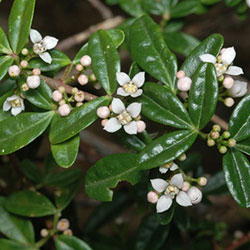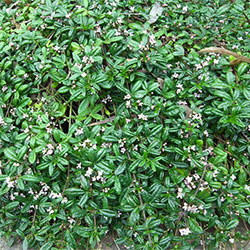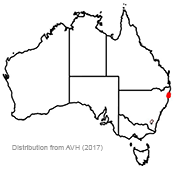Zieria prostrata
 |
 |
Headland Zieria
Zieria prostrata is a particularly striking species in the Rutaceae, a family which also includes cultivated citrus and natives such as Correa and Boronia. There are over 50 other species of Zieria, which are all endemic to Australia and surrounding islands.
This spreading perennial ground cover has large, smooth, dark green, glossy leaves that are divided into three leaflets. Like most species in the Rutaceae, the leaves contain aromatic oil glands and are highly fragrant. In winter and spring (from late August to early October), light-pink, four-petalled flowers appear. These bisexual flowers resemble white stars against the dark green leaves. Inconspicuous red-green fruits follow in October to November. These are often four-lobed, and dotted with oil glands. Plants are self-fertile and self-pollinating in cultivation.
Zieria prostrata is commonly known as Headland Zieria, as it naturally occurs on coastal heaths. It is restricted to just four headlands in northern New South Wales, 20km north of Coffs Harbour. The species is threatened by invasion of habitat by weedy grasses and bitou bush, as well as trampling by walkers and vehicles, and excessively frequent fires. Due to its limited distribution and low population, this species is classified as endangered on both a state and national level.As a ground cover, Zieria prostrata forms mats and mounds, ideal for landscaping and rockeries. On a ledge or in a pot, it will cascade attractively over the edges. It can be reliably grown in a range of soil types and positions in the garden but is best suited to well-draining soil. It can be grown in full sun, but thrives in filtered light under trees. It is frost-hardy once established, tolerates coastal salt spray, but performs best in a sheltered position and will not survive being walked across. Robust when it comes to disease, it is physically delicate.
Although relatively scarce in the wild, it is readily available from native nurseries under the cultivar name Zieria 'Carpet Star'. Easily found during the spring flowering period, it is probably better to wait until after summer to plant, to avoid transplant shock. To propagate take cuttings of firm growth, using hardy new wood after the summer growing season. Soft growth will wilt before roots establish. A method for hardening off the related Z. obcordata, which is likely to give good results is to dip semi-firm cuttings&mdashwith soft growth tips removed—in rooting hormone, then pot in 5:1 perlite/coir mixture. Allow the cuttings to establish in pots in low humidity for at least two months. Once well-established and developing new shoots, plant out into potting mix with 30% perlite.
This species is not prone to disease and its aromatic leaves help keep pests at bay. It should not require pruning but may be pruned after flowering as required, and can withstand some dry spells. Fertiliser is not necessary, but if desired, use a slow release, low phosphorus option.
Claudia Schipp, Volunteer Botanical Training Program Participant 2017
Name meaning: Zieria prostrataZieria - named in honour of Johannis Zier, an 18th century Polish botanist and cryptogam (ferns, mosses, lichen and fungi) specialist prostrata - refers to the habit of the plant, which grows flat along the ground |
References:
Armstrong, J. A. (2002) The genus Zieria (Rutaceae): a systematic and evolutionary study. Australian Systematic Botany 15(3): 277-463.
Armstrong J. A. & Harden G.J. (1991) Zieria prostrata J.A.Armstr. in PlantNET (The NSW Plant Information Network System). Available at http://plantnet.rbgsyd.nsw.gov.au/cgi-bin/NSWfl.pl?page=nswfl&lvl=sp&name=Zieria~prostrata [Accessed Feb. 2017].
Bushland Flora. (2017) Australian wholesale nursery: Zieria prostrata. Available at http://www.bushlandflora.com.au/individual_plant.php?p=Zieria%20prostrata&uid=1735 [Accessed Feb. 2017].
Butler, G. (1993) Hort Notes - A hardy star of the Rutaceae family. Australian Horticulture 91(10): 106.
Carmen, P. (2010) The Australian National Botanic Gardens' Role in Securing Endangered Species: A Focus on Zieria obcordata. Australian Plants: special 40th anniversary Australian National Botanic Gardens issue. Society for Growing Australian Plants 25(202): 316–320.
Department of the Environment (2017) Zieria prostrata in Species Profile and Threats Database. Department of the Environment. Available at http://www.environment.gov.au/cgi-bin/sprat/public/publicspecies.pl?taxon_id=56782 [Accessed Feb 2017].
Knight, J. (2015). Native plant profile – If only I weren’t a Zieria. Native Plants for New South Wales 50(2): 16–19.
NSW National Parks & Wildlife Service (1998) Zieria prostrata Recovery Plan - 1999–2001. NSW NPWS. Available at http://www.environment.gov.au/biodiversity/threatened/publications/recovery/z-prostrata/index.html [Accessed Feb 2017].
Threatened Species Scientific Committee (2016) Approved Conservation Advice for Zieria prostrata (Headland Zieria). Department of the Environment. Available at http://www.environment.gov.au/biodiversity/threatened/species/pubs/56782-conservation-advice-15072016.pdf [Accessed Feb 2017].
White, R. (2017) ANBG Horticulturalist. Personal communication.
![An Australian Government Initiative [logo]](/images/austgovt_brown_90px.gif)


